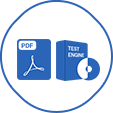Last Update 21 hours ago Total Questions : 139
The ISACA Certified Cybersecurity Operations Analyst content is now fully updated, with all current exam questions added 21 hours ago. Deciding to include CCOA practice exam questions in your study plan goes far beyond basic test preparation.
You'll find that our CCOA exam questions frequently feature detailed scenarios and practical problem-solving exercises that directly mirror industry challenges. Engaging with these CCOA sample sets allows you to effectively manage your time and pace yourself, giving you the ability to finish any ISACA Certified Cybersecurity Operations Analyst practice test comfortably within the allotted time.
An employee has been terminated for policy violations.Security logs from win-webserver01 have been collectedand located in the Investigations folder on theDesktop as win-webserver01_logs.zip.
Generate a SHA256 digest of the System-logs.evtx filewithin the win-webserver01_logs.zip file and providethe output below.
Your enterprise has received an alert bulletin fromnational authorities that the network has beencompromised at approximately 11:00 PM (Absolute) onAugust 19, 2024. The alert is located in the alerts folderwith filename, alert_33.pdf.
What is the name of the suspected malicious filecaptured by keyword process.executable at 11:04 PM?
Analyze the file titled pcap_artifact5.txt on the AnalystDesktop.
Decode the targets within the file pcap_artifact5.txt.
Select the correct decoded targets below.
10cal.com/exam
clOud-s3cure.com
c0c0nutf4rms.net
h3avy_s3as.biz
b4ddata.org
The CISO has received a bulletin from law enforcementauthorities warning that the enterprise may be at risk ofattack from a specific threat actor. Review the bulletin
named CCOA Threat Bulletin.pdf on the Desktop.
Which of the following domain name(s) from the CCOAThreat Bulletin.pdf was contacted between 12:10 AMto 12:12 AM (Absolute) on August 17, 2024?
Your enterprise SIEM system is configured to collect andanalyze log data from various sources. Beginning at12:00 AM on December 4, 2024, until 1:00 AM(Absolute), several instances of PowerShell arediscovered executing malicious commands andaccessing systems outside of their normal workinghours.
What is the physical address of the web server that wastargeted with malicious PowerShell commands?
On the Analyst Desktop is a Malware Samples folderwith a file titled Malscript.viruz.txt.
Based on the contents of the malscript.viruz.txt, whichthreat actor group is the malware associated with?
Following a ransomware incident, the network teamprovided a PCAP file, titled ransom.pcap, located in theInvestigations folder on the Desktop.
What is the name of the file containing the ransomwaredemand? Your response must include the fileextension.

